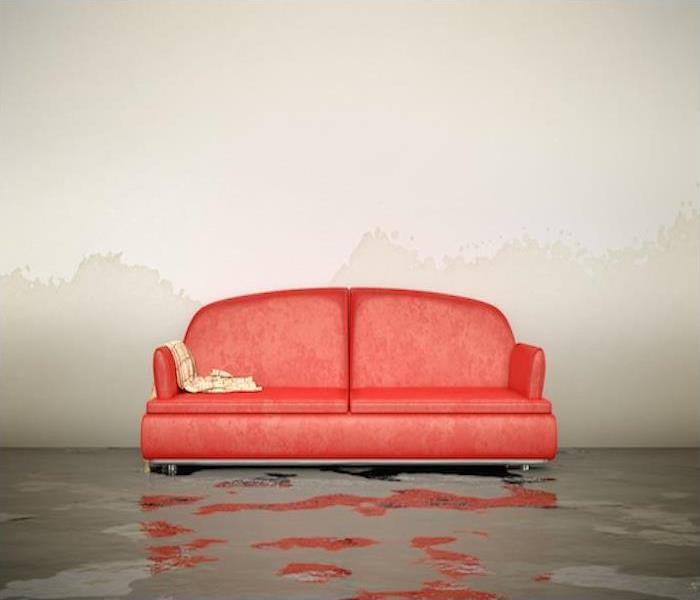Tips to Avoid Water Damage
12/16/2016 (Permalink)
Water damage is a serious risk for buildings. If not addressed immediately, it can create irreparable damage to your personal possessions, the structural stability to the building, and can cause health hazards for occupants. However, there are steps that you can take to help avoid such a situation.
Identifying Potential Hazards
The first step to avoiding water damage is to identify the potential hazards where water damage can occur. Most notably, if you have any leaks or cracks that can allow water in, they should be fixed as soon as possible.
Windows and Doors
As usual openings into the building, windows and doors are common sources of water damage. Regularly checking your windows and doors for leaks will help ensure that they don’t cause water damage problems. If there are leaks, it may be an issue with the sealing around the opening.
Roof
Oftentimes, water damage initially comes from the roof. When leaks or roof damage allow water to infiltrate the building, that water will slowly make its way through the home damaging the attic, walls, and eventually the floors. Primary issues that result in water damage from the roof are leaks around vents for the exhaust for plumbing, rooftop air conditioning units, and other types of specialized equipment. Another common problem is with the roof’s drainage system, particularly the gutters. Making sure your gutters are in good condition and draining water properly will ensure it doesn’t cause water damage to the building or its foundation.
Foundation and Exterior Walls
Water can do the most damage to the foundation and exterior walls. Water damage to these parts of the building can compromise its structural integrity and cause openings such as doors and windows to stick. To avoid any danger of damage occurring to these areas, seal any cracks or hold that may have accumulated in the exterior walls, joints, and foundation. You also need to make sure that your yard slopes down away from the foundation and that the roof drainage system directs water well away from the building.
Plumbing
Inside the building, most water damage problems occur from areas where water use is common. Make sure that there are no leaks in the plumbing fixtures, that the pipes are not dripping, that the drains are not clogged, and that any water drainage systems are not defective.
Heating, Ventilation, and Air Condition (HVAC)
HVAC systems are made up of various components that can cause the accumulation of moisture in a building. Some of these components include chilled water piping and condensation drains. If the building is in a humid climate, a HVAC system serves the purpose of reducing the ambient air moisture level. If the system is not working properly, it will not do this which could result in water damage.
Inspect and Maintain
A key to keeping water damage from negatively affecting your home is to decrease the chances that water damage can occur. The best way to do this is to regularly inspect and maintain any parts of your home that could potentially be vulnerable to water damage or water intrusion.
Flashing and Sealants
The purpose of flashing is to prevent water from entering the home where two different types of building materials come together. Flashing is usually a thin metal strip and can be found around doors, windows, and roofs. Similarly, sealants and caulking are typically applied to prevent any moisture intrusion at the building’s joints. To keep water from slipping past these parts of the building, they must be well-maintained and in good condition.
Vents
If your vents are not properly maintained, they can be hazards for water damage. To avoid such a problem, all vents in the building should have the appropriate hoods, exhaust to the exterior, and should be in good working order.
HVAC
Many HVAC systems are made up of several components that could potentially cause water damage if regular maintenance is ignored. Check all these components such as water lines, pumps, and air handlers for leaks. You should also make sure that the drain lines are clean and don’t have any obstructions and that the ductwork is insulated so it prevents condensation on exterior surfaces.
Humidity
The relative humidity of a building should typically be 30 percent to 50 percent. If the humidity is too high, it will likely show through condensation on the windows, wet stains on the walls and ceilings, or musty smells.
Moist Areas
If there are any areas of the building that commonly become moist for any reason, these areas should be cleaned off and the area where the moisture frequently collects should be dried.
If not taken care of immediately, water damage can have very negative effects on a building. It can cause severe damage to personal possessions, cause damage to walls and floors, and make the building uninhabitable by putting into question its structural integrity. These tips will help you avoid having to deal with such a situation. If you do suffer any type of water damage to your home, call the professionals at SERVPRO for a full restoration.

 24/7 Emergency Service
24/7 Emergency Service
